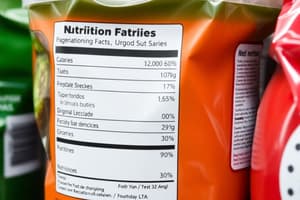Podcast
Questions and Answers
What is a key reason for the importance of food labeling?
What is a key reason for the importance of food labeling?
- To enhance the aesthetic appeal of packaging
- To provide detailed ingredient descriptions
- To assist consumers in making informed food choices (correct)
- To increase the marketability of food products
Which of the following is NOT a general regulation for food labeling?
Which of the following is NOT a general regulation for food labeling?
- Ingredient lists must be clearly stated
- Labels must be in an easily readable font
- Nutritional information must be provided
- Labels must include marketing slogans (correct)
What type of information is typically required on food product labels?
What type of information is typically required on food product labels?
- Manufacturer's financial statements
- Nutritional facts and ingredient list (correct)
- Citations of food safety studies
- Best-selling price of the food item
Which statement about food labeling is accurate?
Which statement about food labeling is accurate?
Which of the following is NOT a required piece of information on a food product?
Which of the following is NOT a required piece of information on a food product?
What is essential to include in a food product label for consumers with allergies?
What is essential to include in a food product label for consumers with allergies?
Why is being aware of food labeling information essential?
Why is being aware of food labeling information essential?
Which of the following components must be included in the ingredient list of a food product?
Which of the following components must be included in the ingredient list of a food product?
What are consumers primarily interested in regarding food products today?
What are consumers primarily interested in regarding food products today?
What has prompted the development of expanded nutrition guidelines for food labels?
What has prompted the development of expanded nutrition guidelines for food labels?
Which element provides essential dietary information on a food product?
Which element provides essential dietary information on a food product?
What is the primary concern of consumers beyond food safety?
What is the primary concern of consumers beyond food safety?
What information must be present in a food product packaging to protect consumers?
What information must be present in a food product packaging to protect consumers?
Which factor has become less significant to consumers in food choices?
Which factor has become less significant to consumers in food choices?
What aspect of food labels has seen a recent trend in development?
What aspect of food labels has seen a recent trend in development?
What is the primary demand of consumers regarding food products today?
What is the primary demand of consumers regarding food products today?
What can be inferred about the development of expanded nutrition guidelines for food labels?
What can be inferred about the development of expanded nutrition guidelines for food labels?
What is a notable difference between food labeling regulation in the UK and the USA?
What is a notable difference between food labeling regulation in the UK and the USA?
Why might consumers be interested in the positive nutritional value of food?
Why might consumers be interested in the positive nutritional value of food?
Which statement best describes the complexity of food labeling regulation in the UK?
Which statement best describes the complexity of food labeling regulation in the UK?
What aspect of food labeling is more critical to consumers now compared to the past?
What aspect of food labeling is more critical to consumers now compared to the past?
Which of the following is true regarding the regulation of food labeling?
Which of the following is true regarding the regulation of food labeling?
What is likely a consequence of consumers wanting more information on food products?
What is likely a consequence of consumers wanting more information on food products?
What can be inferred about consumer awareness of food labeling regulations?
What can be inferred about consumer awareness of food labeling regulations?
What aspect of food labeling may lead to confusion among consumers?
What aspect of food labeling may lead to confusion among consumers?
Flashcards
Why is Food Labeling Important?
Why is Food Labeling Important?
Provides consumers with essential information about the food they are buying, helping them make informed dietary choices.
General Food Labeling Regulations
General Food Labeling Regulations
A set of rules and guidelines that specify what information must be included on food labels.
Information Required on Food Product
Information Required on Food Product
The name of the product, the list of ingredients, the net weight, the manufacturer's address, and the nutrition facts panel are some examples.
Beyond safety, consumers want..
Beyond safety, consumers want..
Signup and view all the flashcards
Nutritional Value
Nutritional Value
Signup and view all the flashcards
Expansion of Food Label Guidelines
Expansion of Food Label Guidelines
Signup and view all the flashcards
What's the goal of expanded food labels?
What's the goal of expanded food labels?
Signup and view all the flashcards
Product Name
Product Name
Signup and view all the flashcards
Ingredient List
Ingredient List
Signup and view all the flashcards
Allergenic Ingredients
Allergenic Ingredients
Signup and view all the flashcards
Nutritional Information
Nutritional Information
Signup and view all the flashcards
Quantity
Quantity
Signup and view all the flashcards
Beyond Food Safety
Beyond Food Safety
Signup and view all the flashcards
Expanded Food Labels
Expanded Food Labels
Signup and view all the flashcards
What's in the Food?
What's in the Food?
Signup and view all the flashcards
Informed Food Choices
Informed Food Choices
Signup and view all the flashcards
Food Labeling in UK
Food Labeling in UK
Signup and view all the flashcards
Food Labeling in USA
Food Labeling in USA
Signup and view all the flashcards
Beyond Safety
Beyond Safety
Signup and view all the flashcards
Nutritional Importance
Nutritional Importance
Signup and view all the flashcards
Study Notes
Food Labeling - I
- Food labeling is important because consumers want to know the nutritional value of food, not just if it's safe to eat.
- Expanded nutrition guidelines for food labels have been developed.
- UK food labeling laws are complex due to numerous reforms.
- In the USA, the FDA regulates food labeling.
- Food labels must contain specific information to inform consumers.
Information Required on Food Products
-
Product name: The name must be clear and describe the product accurately. Processed foods need to state the process. Names must differentiate between similar products (e.g., "orange drink" vs. "orange-flavored drink").
-
Ingredient list and quantity: Ingredient lists must be in descending order of weight unless below 5g. All ingredients, including additives and water, must be listed. Allergens must be clearly indicated according to EU regulations (2004).
-
Allergenic ingredients: Food labels must clearly state if they contain ingredients to which people can be allergic. A list of specific allergens to be stated on the label is provided: Celery, Cereal containing gluten-wheat, rye, oat, barley, Milk, Eggs, Fish, Mustard, Soybeans, Peanuts, Sesame seeds, Sulphur dioxide and sulphites at levels above 10 gm per kg or liter.
-
Nutritional information: If a manufacturer claims a product is low in sugar or has other nutritional characteristics, the product information must be supported with nutritional data (usually in a table format).
-
Medicinal or Nutritional Claims: Medicinal or nutritional claims are strictly regulated. Claims about treating, preventing, or curing diseases are prohibited. Claims about vitamins and fat reduction require the food to meet specified standards, and the terms must be presented according to relevant regulations.
-
Nutrition claims: A nutrition claim is non-labeling information that states if a food has a high or low amount of a specific nutrient.
-
Different types of nutrition claims are discussed, for example referring to nutrient content (e.g., source of iron or iron content) and nutrient function (e.g., helping children develop stronger bones). For example, "contains 25% more Iron".
-
Guidelines for nutrient content claims: FSA (Food Standards Agency) guidelines exist for sugar, fats, saturated fats, and sodium (salt). Specific guidelines exist in a tabulated format.
-
Shelf life or Date Tagging: Labels should specify how long the product lasts after purchase or opening, and include date tagging information pertinent to food safety.
-
There are two types of date tagging information: Use-by dates and Best-before dates.
-
Use-by date: This date indicates when a product should be consumed to ensure safety and quality of the food to prevent food poisoning. It’s used for foods that are typically stored cold.
-
Best-before date: This date is more about quality than safety (except for eggs), indicating when the product might begin to degrade in quality, not necessarily be unsafe to consume. Best Before dates indicate foods' quality, not their safety limit and consult storage instructions for optimal results.
-
Regulation on Best Before dates: The best before date must include the "Day", "Month", or "Year", depending on shelf-life (e.g., foods with a shelf life of 3 months or less use "Day" with the "Best before" date; foods with a shelf-life between 3 months to 18 months use “Month” with the "Best before"; and foods with a shelf-life longer than 18 months use “Year” with the "Best before")
-
Storage instruction: Labels must include specific storage conditions to maintain the product’s shelf-life and freshness.
-
Name and address of manufacturer/packer/seller/distributor: These details should be included on the product packaging so that customers can contact the manufacturer with any questions.
-
Country of origin: The country of origin must be accurately stated on the label; for example, "English Brie Cheese" if produced in France.
-
Weight or volume: The weight or volume of the product should be clearly shown on the label.
-
Instructions for Use: Instructions for preparing or cooking the product are required on the package. This includes oven temperatures, cooking times, and microwave instructions where applicable; to maintain safety and minimize the risk of food poisoning. Instructions should also include core temperatures, e.g., heating to a core temperature of 75°C.
-
Presentation and Sectioning: Product labels must be legible, written in English, and have all important information in the same visible section. For example, the product name, date, weight, and quantity must be visible together. The label must also be easy to read. The manufacturer may include other languages.
Studying That Suits You
Use AI to generate personalized quizzes and flashcards to suit your learning preferences.



